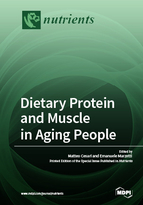Dietary Protein and Muscle in Aging People
A special issue of Nutrients (ISSN 2072-6643).
Deadline for manuscript submissions: closed (15 June 2018) | Viewed by 120292
Special Issue Editors
2. Geriatric Unit, Fondazione IRCCS Ca’ Granda Ospedale Maggiore Policlinico, Milan, Italy
Interests: frailty; sarcopenia; geriatric medicine; integrated care; healthy ageing
Special Issues, Collections and Topics in MDPI journals
Interests: Muscle function; Skeletal Muscle; Geriatrics; Frailty; Sarcopenia; Mitochondria; Biomarkers
Special Issues, Collections and Topics in MDPI journals
Special Issue Information
Dear Colleagues,
This Special Issue of Nutrients, entitled “Dietary Proteins and Muscle in Aging People”, welcomes the submission of manuscripts either reporting original research or reviewing the scientific literature. Manuscripts should focus on the mechanisms linking dietary protein with muscle quality and quantity. Articles presenting (both positive and negative) results from clinical trials testing protein interventions on muscle mass and function are welcome. The Special Issue aims at including articles spanning different disciplines (e.g., nutritional sciences, geriatrics, sports medicine, public health, rheumatology, oncology, cardiology, orthopedics) for exploring the topic of interest. Reports from basic up to clinical and population research are suitable. Articles adopting a longitudinal approach or reporting data from life-long interventions/observations in the exploration of the theme will be given special consideration.
Potential topics include, but are not limited to:
- Description of patterns of dietary protein consumption across life
- Influence of dietary protein intake on the functional status of older people
- Preclinical and clinical studies describing the mechanisms through which protein intake modifies muscle mass and function
- Protein/amino acid supplementation interventions against sarcopenia, cachexia or disease conditions associated with muscle wasting in old age
- Disease-specific alterations modifying the effects of dietary protein intake on the skeletal muscle
- Interactions of dietary protein intake and gut microbiota on skeletal muscle
Dr. Emanuele Marzetti
Guest Editors
Manuscript Submission Information
Manuscripts should be submitted online at www.mdpi.com by registering and logging in to this website. Once you are registered, click here to go to the submission form. Manuscripts can be submitted until the deadline. All submissions that pass pre-check are peer-reviewed. Accepted papers will be published continuously in the journal (as soon as accepted) and will be listed together on the special issue website. Research articles, review articles as well as short communications are invited. For planned papers, a title and short abstract (about 100 words) can be sent to the Editorial Office for announcement on this website.
Submitted manuscripts should not have been published previously, nor be under consideration for publication elsewhere (except conference proceedings papers). All manuscripts are thoroughly refereed through a single-blind peer-review process. A guide for authors and other relevant information for submission of manuscripts is available on the Instructions for Authors page. Nutrients is an international peer-reviewed open access semimonthly journal published by MDPI.
Please visit the Instructions for Authors page before submitting a manuscript. The Article Processing Charge (APC) for publication in this open access journal is 2900 CHF (Swiss Francs). Submitted papers should be well formatted and use good English. Authors may use MDPI's English editing service prior to publication or during author revisions.
Keywords
- Proteins
- Diet
- Sarcopenia
- Skeletal muscle
- Cachexia
- Supplementation








